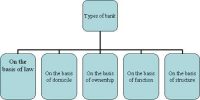The business combination is a method of economic organization by which a common control of greater or lesser completers is exercised over a number of firms which either one operating in competition or independently.
Classification of Business Combination on the basis of Consolidation
Consolidation: Consolidation means to compact alliances which the members are so compactly united as to lose a large measure of independent and autonomous existence. The consolidation affects a greater loss of individuality on the part of their members. Consolidation may be two types. This one-
(i) Partial Consolidation
(ii) Complete Consolidation
Partial consolidation may be three types. These are:
- Trust: Trust is an organization in which shareholders of the constituent organizations transfer a controlling amount of their stock or shares to a board of trustees in exchange for trust certificate. It is the consolidation of a number of companies to enjoy the benefits of monopolistic competition.
- Holding Company: A holding company is one which is formed mainly to acquire the controlling amount of shares or stocks of other companies and thereby to control their policies and operations. A loading company holds directly or through a nominee, a majority of the voting shares of the subsidiary company takes the power to appoint the majority of the members of the directors.
- Community Interest: A community of interest means to a case where a few individuals are the dominant shareholders of two or more companies. Only those persons dominate the board composition and its function that have a controlling interest in the company.
Complete consolidation may be divided into two types. These are Amalgamation and merger. Brief descriptions of these are given below:
- Amalgamation: Amalgamation means the manes of a new company by the coalescence and virtual disappearance of a group of business enterprises. Entities of all the organization under the scheme are lost new one is created.
- Merger: The combination of two or more companies. Generally by offering the stockholders of one company securities to the acquiring company in exchange for the surrender of their stock. In that case, the former company which is absorbed loses its entity. For example, ‘A’ company absorbs ‘B’ Company by buying all of its properties. Here ‘B’ company has lost its entity and is merged in the ‘A’ company.
From the discussion, we can say that business combination may be classified as their nature and organizations characteristics. But whatever it is the main objective of every combination is same to maximize their profit and get facilities from the business combination.
















